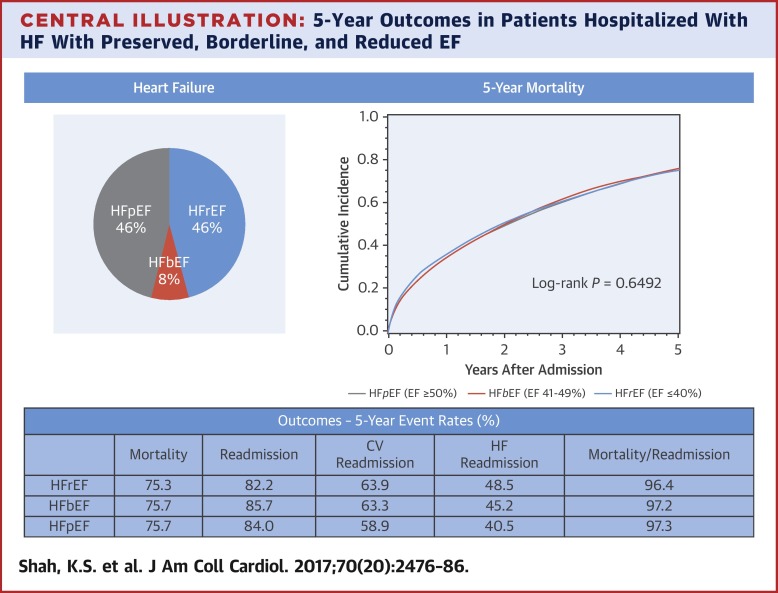当前位置:
X-MOL 学术
›
J. Am. Coll. Cardiol.
›
论文详情
Our official English website, www.x-mol.net, welcomes your
feedback! (Note: you will need to create a separate account there.)
Heart Failure With Preserved, Borderline, and Reduced Ejection Fraction
Journal of the American College of Cardiology ( IF 21.7 ) Pub Date : 2017-11-01 , DOI: 10.1016/j.jacc.2017.08.074 Kevin S. Shah , Haolin Xu , Roland A. Matsouaka , Deepak L. Bhatt , Paul A. Heidenreich , Adrian F. Hernandez , Adam D. Devore , Clyde W. Yancy , Gregg C. Fonarow
Journal of the American College of Cardiology ( IF 21.7 ) Pub Date : 2017-11-01 , DOI: 10.1016/j.jacc.2017.08.074 Kevin S. Shah , Haolin Xu , Roland A. Matsouaka , Deepak L. Bhatt , Paul A. Heidenreich , Adrian F. Hernandez , Adam D. Devore , Clyde W. Yancy , Gregg C. Fonarow

|
BACKGROUND
Patients with heart failure (HF) have a poor prognosis and are categorized by ejection fraction (EF). OBJECTIVES
This study sought to characterize differences in outcomes in patients hospitalized with heart failure with preserved ejection fraction (HFpEF) (EF ≥50%), heart failure with borderline ejection fraction (HFbEF) (EF 41% to 49%), and heart failure with reduced ejection fraction (HFrEF) (EF ≤40%). METHODS
Data from GWTG-HF (Get With The Guidelines-Heart Failure) were linked to Medicare data for longitudinal follow-up. Multivariable models were constructed to examine 5-year outcomes and to compare survival to median survival of the U.S. POPULATION RESULTS
A total of 39,982 patients from 254 hospitals who were admitted for HF between 2005 and 2009 were included: 18,299 (46%) had HFpEF, 3,285 (8.2%) had HFbEF, and 18,398 (46%) had HFrEF. Overall, median survival was 2.1 years. In risk-adjusted survival analysis, all 3 groups had similar 5-year mortality (HFrEF 75.3% vs. HFpEF 75.7%; hazard ratio: 0.99 [95% confidence interval: 0.958 to 1.022]; HFbEF 75.7% vs. HFpEF 75.7%; hazard ratio: 0.99 [95% confidence interval: 0.947 to 1.046]). In risk-adjusted analyses, the composite of mortality and rehospitalization was similar for all subgroups. Cardiovascular and HF readmission rates were higher in those with HFrEF and HFbEF compared with those with HFpEF. When compared with the U.S. population, HF patients across all age and EF groups had markedly lower median survival. CONCLUSIONS
Among patients hospitalized with HF, patients across the EF spectrum have a similarly poor 5-year survival with an elevated risk for cardiovascular and HF admission. These findings underscore the need to improve treatment of patients with HF.
中文翻译:

射血分数保留、临界和降低的心力衰竭
背景 心力衰竭 (HF) 患者预后较差,并按射血分数 (EF) 进行分类。目的 本研究旨在描述射血分数保留的心力衰竭 (HFpEF)(EF ≥ 50%)、临界射血分数(HFbEF)(EF 41% 至 49%)和心力衰竭住院患者的结局差异射血分数降低 (HFrEF) (EF ≤40%)。方法 来自 GWTG-HF(遵循指南 - 心力衰竭)的数据与医疗保险数据相关联,用于纵向随访。构建了多变量模型来检查 5 年结果并比较美国人群的生存率与中位生存率 结果 包括 254 家医院的 39,982 名 2005 年至 2009 年因 HF 入院的患者:18,299 名 (46%) 患有 HFpEF, 3,285 (8.2%) 人患有 HFbEF,18, 398 (46%) 人患有 HFrEF。总体而言,中位生存期为 2.1 年。在风险调整生存分析中,所有 3 组的 5 年死亡率相似(HFrEF 75.3% 与 HFpEF 75.7%;风险比:0.99 [95% 置信区间:0.958 至 1.022];HFbEF 75.7% 与 HFpEF 75.7%;风险比:0.99 [95% 置信区间:0.947 至 1.046])。在风险调整分析中,所有亚组的死亡率和再入院率的复合数据相似。与 HFpEF 患者相比,HFrEF 和 HFbEF 患者的心血管和 HF 再入院率更高。与美国人群相比,所有年龄和 EF 组的 HF 患者的中位生存期明显较低。结论 在因 HF 住院的患者中,EF 谱患者的 5 年生存率同样较差,心血管和 HF 入院风险升高。
更新日期:2017-11-01
中文翻译:

射血分数保留、临界和降低的心力衰竭
背景 心力衰竭 (HF) 患者预后较差,并按射血分数 (EF) 进行分类。目的 本研究旨在描述射血分数保留的心力衰竭 (HFpEF)(EF ≥ 50%)、临界射血分数(HFbEF)(EF 41% 至 49%)和心力衰竭住院患者的结局差异射血分数降低 (HFrEF) (EF ≤40%)。方法 来自 GWTG-HF(遵循指南 - 心力衰竭)的数据与医疗保险数据相关联,用于纵向随访。构建了多变量模型来检查 5 年结果并比较美国人群的生存率与中位生存率 结果 包括 254 家医院的 39,982 名 2005 年至 2009 年因 HF 入院的患者:18,299 名 (46%) 患有 HFpEF, 3,285 (8.2%) 人患有 HFbEF,18, 398 (46%) 人患有 HFrEF。总体而言,中位生存期为 2.1 年。在风险调整生存分析中,所有 3 组的 5 年死亡率相似(HFrEF 75.3% 与 HFpEF 75.7%;风险比:0.99 [95% 置信区间:0.958 至 1.022];HFbEF 75.7% 与 HFpEF 75.7%;风险比:0.99 [95% 置信区间:0.947 至 1.046])。在风险调整分析中,所有亚组的死亡率和再入院率的复合数据相似。与 HFpEF 患者相比,HFrEF 和 HFbEF 患者的心血管和 HF 再入院率更高。与美国人群相比,所有年龄和 EF 组的 HF 患者的中位生存期明显较低。结论 在因 HF 住院的患者中,EF 谱患者的 5 年生存率同样较差,心血管和 HF 入院风险升高。











































 京公网安备 11010802027423号
京公网安备 11010802027423号